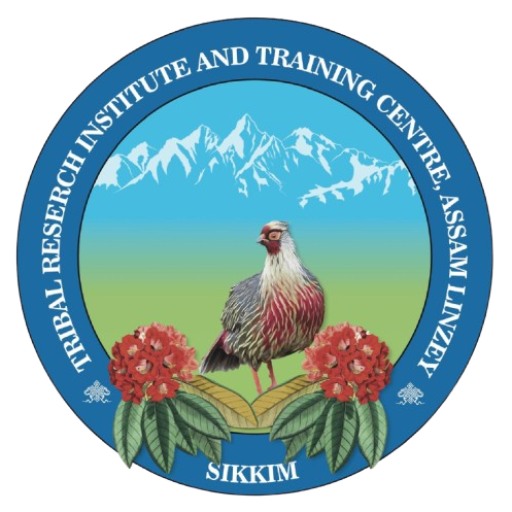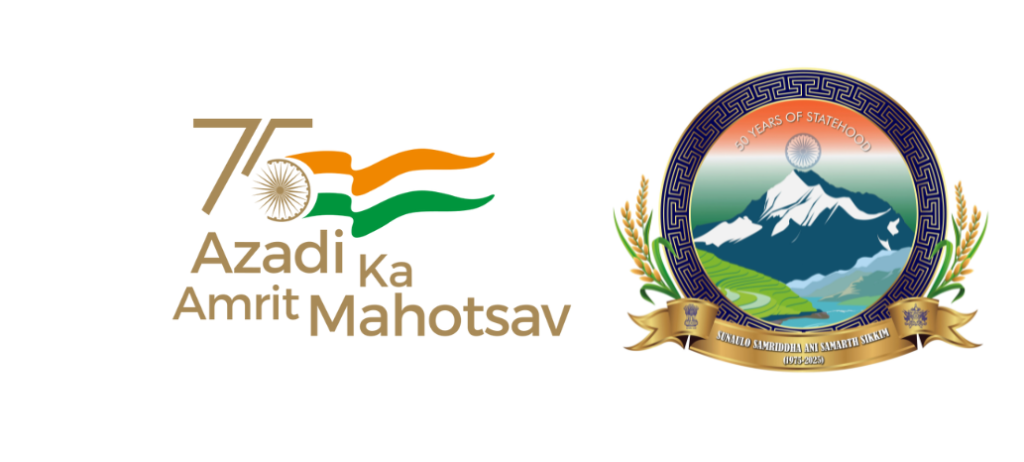SHERPA TRIBE
INTRODUCTION
Sikkim is the land of peace and tranquility, a land blessed by Guru Padmasambhava in 8th century, which was initially known as Beyul Demazong1 and Mayal-Lyang (J.R Subba: 2007). It is a land of natural beauty and peaceful co-existence of different communities, namely Bhutia, Lepcha and Nepali.The Sherpa is an ethnic group that lives on the higher mountainous region of Eastern Himalayas mainly distributed in eastern Nepal, Sikkim, Darjeeling and Bhutan. Sherpa shares a common Tibeto-Burman language and follows an ancient form of Buddhism tradition and way of life supports and suggestsa historical root back to Tibet.
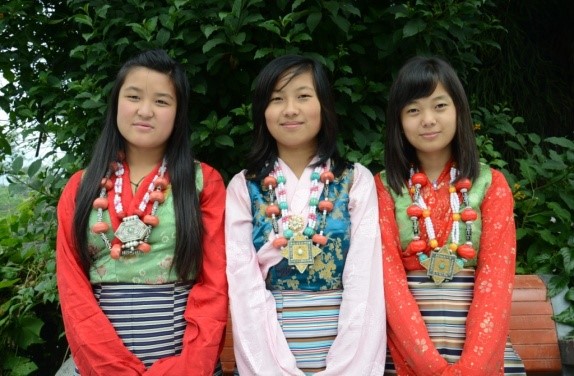
The title ‘Sherpa’ has been popularized throughout the world especially for the reasons of high-altitude mountaineering and living in a harsh and rugged topography of Himalayas. Oral history suggest that ‘Sherpa’ evolved for the word ‘shar-pa’ which is derived from the combination of shar meaning east and pa or wa suffix for belonging. The literal meaning translation of shar-wa or Sherpa is “people from the east”
Sherpa is one of the scheduled tribe of Sikkim as according to the scheduled tribes order 1978 but it is considered as one of the sub-tribes of Bhutia. It is not in 1978 that Sherpa community considered one of Bhutia sub-tribes, but there are evidence like census of 1911, which records population of Sikkim as Bhutia including Sherpas, Lepchas and Paharias.
Since, Sherpas comes as sub-tribes of Bhutia, there is no separate enumeration of data regarding Sherpa’s demographic, socio-economic conditions, and there are no demographic details available. But as according to Subba (2007; 281) the Sherpa community comprised 25,808 persons constituting 4.45 percent of the state’s population on the basis of voter’s list of 2004. The Sherpa household numbered 5,174 consisting 4.63 percent of the total household in the state.
ORIGIN AND HISTORY
Today, Sherpas are known as highlanders, people living in high range mountains, with harsh and challenging life on rugged topography. They are of Tibetan origin with faith in nyingmapa school of Mahayana Buddhism and language of their own with Sambota Script. There is a consensus among the historians, researchers, Sherpas and other communities that Sherpas original homeland is the kham region of Tibet. But the matter of why and how they migrated to different parts of the present homeland is diverse and full of different opinions. Here is one such explanation based on oral history and legends that presents how and why they migrated to present homelands.
As Sherpa, L.N., (2008; 3) writes that Kham is a rugged region in eastern Tibet dissected by many rivers including the headwaters of the Mekong, Yangtze, and Salween, the area was also known as the “Chhu Shi Gang Druk”, the four rivers and six ridges region. A particular ridgeline called Salmo Gang in the Kham Minyag area is thought to be one place where Sherpa originated. It was in around 1480s, Sherpa ancestors were driven out of the ancestral homeland of kham, probably because of sectarian conflict within Mahayana Buddhism. After leaving kham, they travelled through U and Tsang, settling there temporarily before crossing over the Himalayas to reach their current homeland of eastern Himalayas. After Chinese takeover in 1950s, kham split into different administration of TAR (china) such as Sichuan, Yunnan, and Qinghai provinces.
The connection of Sherpa and Sikkim has its link to the journey of Guru Padmasambhava in 8th century when he purified the land and later considered it as Sangrila. Sherpa ancestors were Nyingmapa followers popularly known as the ‘Red Hat Sect’ particularly the group that believed in the hidden treasures including the tradition of Beyul (hidden valleys). Tsongkhapa is believed to be the one who initiated the Gelug sect in 1409 in order to reform and strengthen Buddhism. Gelug means rule of virtues, this sect is known as ‘Yellow Hat Sect’ which they consider themselves superior and was rigid form of Mahayana Buddhism.
In the meantime, Mongols captured much of Asia and Europe, in fact in 1543; Mongol leaders adopted the Gelug sect as their religion. Therefore, the tradition of the title “Dalai Lama” evolved. In 1575, the head of the Gelug sect SonamGyatso was given the title of 3rd Dalai Lama. In 1643, at the time of 5th Dalai Lama, Gushri Khan then leader of a Mongol tribe was asked by the Gelugpa to help suppress rival religious schools and empower the Dalai Lamas. As a result, the Gelugpa became extremely powerful and pressured other schools to convert to their beliefs (Sherpa, 2008; 6). Moreover Sherpa (2008; 6) writes that there are stories of violent religious conflict among the different sect during the 16th century. Many Nyingma monasteries were converted to Gelugpa Institution; resulting into the difficult situation for nyingma spiritual leaders tocontinue their traditional way of practicing Buddhism. At the meantime, there were groups within Nyingma School who had a spiritual belief in terma (sacred hidden treasures), later terton (treasure revealers) discovered these treasures, it is believed that keys to the beyul or hidden valleys are one such treasures.
Beyul are hidden valleys that areblessed by Guru Padmasambhavaas refuge for his followers at times of great difficulty. A key to a beyul will be found at a specific time and by treasure revealers. All life within a beyul is considered sacred and protected. As such, Sikkim as initially known as beyuldemazong was one of the beyul along with Himalayan region of Nepal, Tibet, Bhutan, India, China and Pakistan. Lama (2004; 257) writes that Sherpa legend however indicates their original place as Shera-Ta in the kham province of Tibet. Following their tantric leader, named Shyr-Toong-Gyl, the Sherpas migrated to the regions of Solu-khumbu in Nepal and some of them advanced further towards the hilly areas of Darjeeling, Bhutan and Sikkim.
It is clear that Sherpa migrated from kham region of Tibet, but much unclear that which way they migrated, especially when popular western writings about the khumbuSherpas and their art of mountaineering earned worldwide attention. There is a need of further research about the routes of migration to better understand the cultural and traditional history of Sherpa. The initial record of Sherpa in Sikkim has been mentioned by Subba (2007; 279) that in early first half of 18thcentury, Phuntsog Namgyal, Chogyal of Sikkim married the granddaughter of Rabden Sherpa. Further writes that Sherpa were in Sikkim long before the date given by the western social authorities. They gradually accumulated with Bhutia of Sikkim alike other sub-tribes. This accumulation of Sherpa in Bhutia in Sikkim led to the ambiguous history about Sherpa but the census record holds data about the population of Sikkim in 1911 as Bhutia including Sherpa. This suggests that though Sherpa are under Bhutia but they are not adjunctly Bhutia.
GEOGRAPHICAL DISTRIBUTION
There was a time when Sikkim had territories that was spread across the larger portion, the boundary in the north was Dipdala in the north, Shingsa Dag-Pay, Walang, Yangmag Khangchen Yarlung and Timur Chorten in the west, down along the Arun and DudhKosirivers, down to the MahaNodi, Nuxulbari and Titaliyain the south, on the east Tagong La and Tang La on the north (subba, 2007; 289). Similarly Sherpa settlement is found in the Sikkim, Tibet, and eastern side of Nepal, Darjeeling, Bhutan, (Europe and America).
Table 1: Showing areas with higher concentration of Sherpas population in Sikkim
higher elevation of Tashiding, Begha, Upper Bermoik
Ralang, Nayabusty, Wok, Dew-Damthang, Jaubari, Basghari, Perbing, Temi, Namchi, Kewzing, Bermoik-Palak, Phali-Parengtaar, Ben, Thingrithang.
JN Road, Khamdong, Busuk, Bojoghari.
Kabi Tingda
Phadamchen, Nimachen, Bouchen, Phengdong, Agamlok, Lafa, Chujachen, Rongli, Changu, Gnathang, Kupup, Zaluk, Pathing, Tokchi (pakyong)
Ribdi, Bharang, Okharey, Upper Thambong, Siribadam, Singling and Buriakhop
SHERPA CLANS (sherwiru)
The Sherpa are divided into 25 paternal clans group and sub-groups. Ru literally means “bone’: Sherpa believe that a child inherits bone from the father and blood from the mother. It is generally accepted that the four original Clans (Lama Serpa, Chawa, Minyagpa and Thimmi) came into existence as paternal clans. Other clans are formed as sub-clans of the original four paternal clans. The paternal clans and its sub-clans are given below:-
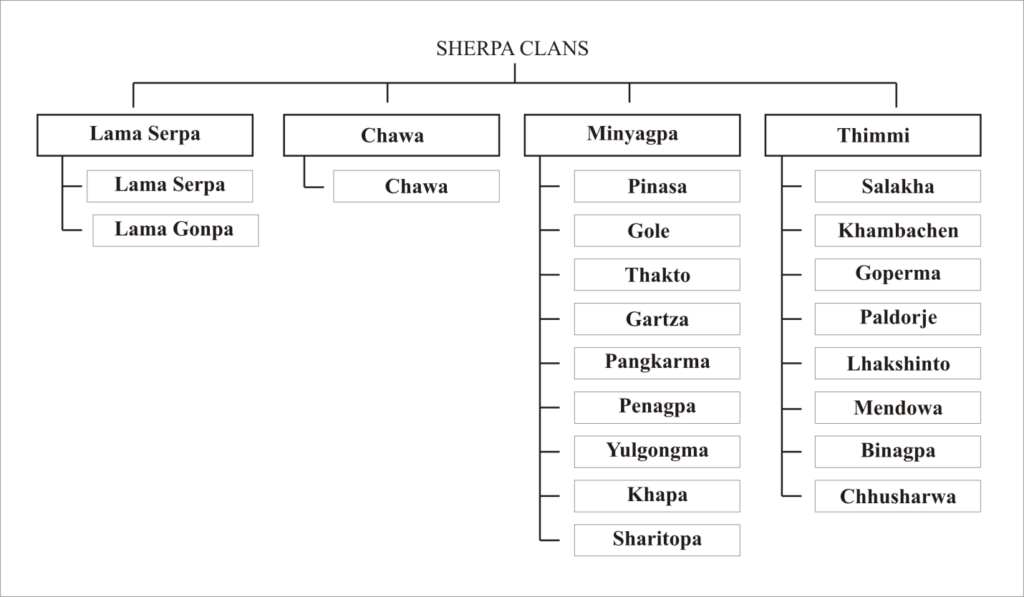
The Lama clan came as the Lama Serpa and Lama Gonpa brother clans. The chawa remained a single clan that originated from a lama and his family. The Thimmi clan gave rise to the Salakha, Lhakshinto, Kambache, Goparma, Paldorje, Binagpa, Mendowa and Chhusharwa. The Minyagpa gave rise to the Pinasa, Gole, Gartza, Pangkarma, Thakto, Khapa, Penagpa, Shari-topa and Yulgongma brother clans
Other clans that it has come to know in Sikkim are Kerong Khamba in Agamlok and Shosing, Durbiza in Perbing, Phalidara, and Wadimba in Perbing, Thingrithang, Dokchen, Shyangden in Perbing. Sherpa custom does not allow marriage between members of the same clan or brother clans.
CULTURE AND TRADITIONS
1. Festivals
Sherpas of Sikkim are originally of Buddhist faith and almost all the customs, culture and traditions are shaped by the philosophy of Buddhism belief. They celebrate Losar, Nyungne, Lapsang, Dumchi, Mani Rimdu and Yarchang.Other than that Sherpa also celebrated Saga Dawa, DrukpaTshechi, Buddha Jyanti and LhababDuchen. These occasions are religious in nature, with important participation by Lamas and monks. The main deity of Sherpas is Deo Padma Sambat or (Guru Rimpochay). Gumpas are found in almost all Sherpa villages, where they gather together to celebrate their festivals in an epic scale. Losar is the festival celebrated by them at the start of their new year normally in the month of February. Around December, Mani Rimdu is celebrated with different songs and dances. This festival which lasts for five to seven days is organized by gumpa committee. Festival Dumji is organized by the general public. This festival which also lasts for five to seven days is celebrated in the month of July-August and is believed to bestow blessings upon them which they believe would enable them to make their life happy and prosperous. During the festivals people put on their best costumes and wear their jewelry. These are generally made from yak and sheep wool, colored with natural dye. The woolen clothing is thick to suit the cool environment of the Himalayan highlands.
1.1 LOSAR (New Year)
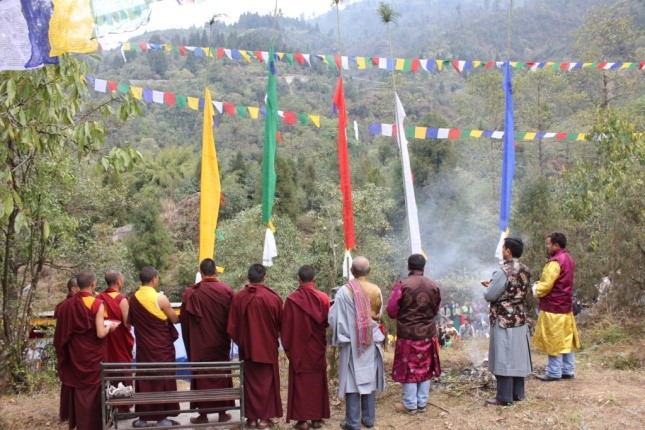
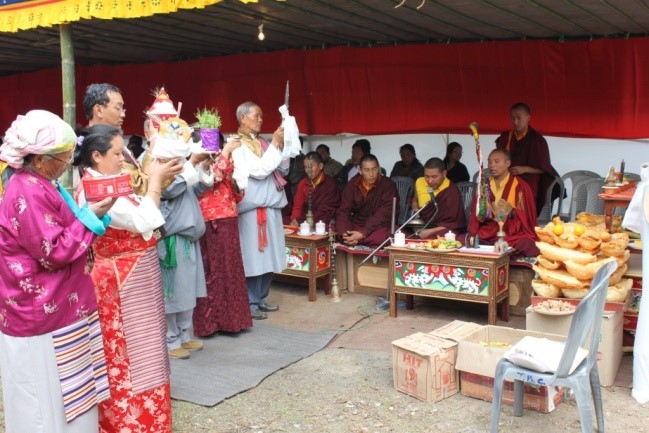
Losar means New Year. It is the festival that celebrates the New Year, and a fun time eagerly anticipated by children and adults alike.On the 29th day of the lunar calendar, families conduct their spring cleaning, removing ceiling soot and garbage. This symbolizes removal of pollution (thrip). In the evening, guthuk a special porridge made of nine different food items, is cooked and shared within the family. On the New Year’s Eve, family members stay home, prepare food and decorate the house. Butter lamps are lit in the evening and Khapse (deep-fried bread), nuts and candies are arranged. New Year’s Day starts with burning of incense in the family heart for the deities. Then pure, fresh water is fetched from the village spring. Water is offered on the altar, and the water kettle is filled for good luck. Sur (incense) is offered to the lu (deities), an offering of serkyimis made to the protector deities, and new prayer flags are installed on the roof tops. The family starts the celebration by offering khapse and chhang porridge (chhanku), then decorates the house by placing dabs of flour (gyen) for good luck. Afterwards, neighbors are invited for a party. Losar parties are hosted in turn by each household in the village and can go on for weeks depending on the size of the village. People will dance and sing until late into the night. Each party ends with blessing drinks (chopa) dedicated to Guru Rinpoche and khata (Scarf) are offered to the departing guests for long life and good health.
1.2 Chirim Lhapsang (Deity Worshiping Ceremony)
This festival is a community sponsored deity worshiping ceremony that takes place in villages. It is meant to invoke the protector deities seeking protection of land, crops, livestock and the people.
1.3 Dumchi (Big Prayer)
Dumchi festival is celebrated in the main village during monsoon, soon after the potato crop is planted and before moving the livestock to alpine pastures. The main purpose of the festival is to celebrate Guru Rinpoche’s birthday, but many of the Sherpa families are celebrated Guru Rinpoche TrunkerTsechu in Sikkim.
1.4 Yarchang (Summer Festival)
Yarchang literally means “summer beer.” This festival begins with a lhapsang ritual (deity worshiping ceremony) to appease the mountain deities and seek their protection. This is followed by parties in the harder’s house and neighbors are invited to share food and drink.
1.5 Mani Rimdu (Mask Dance Festival)
This festival is a religious ceremony dedicated to Chyenrezig, the god of compassion, who brings peace and harmony in the world. Following a weeklong preparation and blessing of the life-giving pills (rilu), the monks hold a three day public ceremony. Tsewang, the life consecration ceremony, is held on the first day, during which the blessed pills are distributed to the public. This is followed by a ritual mask dance (chhaam) performance, featuring various deities, on the second day. The ceremony concludes on the third day with the fire offering rituals (zingsha).
1.6 Nyungne (Fasting Retreat)
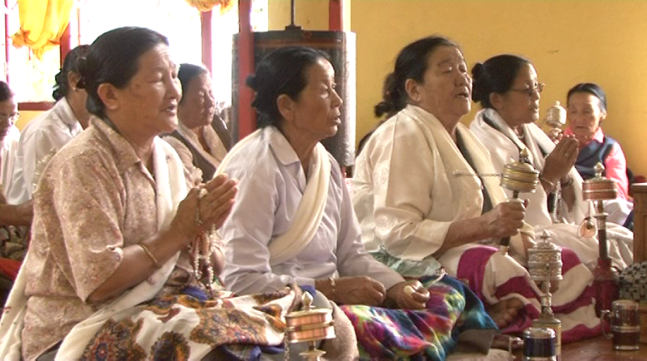
Nyungne are held at a monastery, participants take part in a retreat involving several days of fasting and silence. Nyungne is organized by the monastery committee or sponsored by individuals. The aim of ritual is to perform a symbolic abstinence from worldy activities and practice renunciation. This practice helps personal spiritual development and confers merit. The Nyungne rituals generally last for three days. The first day sokjya, participants consume three times food. On the second day nakche, participants fast and maintain silence. They say prayers and mantras silently, circumambulating monasteries and sacred sites during breaks. On the last day chowa, fasting ends and eating and drinking begins.
2. Religion
The Sherpas are the followers of the Nyingmapa sect of Buddhism.Many of the great Himalayan Mountains are worshiped as gods. Each Sherpa villagers recognizes mountain gods identified with certain peaks that are their protective deities.
The Sherpa perform many rituals for different purposes. Rituals are performed to heal sickness, to appease deities, to promote peace, to earn religious merit and to avoid misfortune. Many of these ritual traditions are inherited from the ancient Phenpu (Bon) religion. Rituals are performed by learned priests, village shamans and lay practitioners alike. They require particular ritual items or objects. Most wooden ritual objects are locally made whereas the finer metallic objects are imported from elsewhere.
Rituals objects are kept in a special place in the house, called chhosham. It is a fully carved wooden cabinet decorated with traditional motifs. The Nyingmapa treasure the statues of Chyenrezig (in the right), Wopagme (in the middle) and Guru Rinpoche (in the left) are placed in the chhosham. They represent the body of religion (chho-kyi-ku), the body of enjoyment (long-chod-kyi-ku) and the transformation body (trul-pei-ku) respectively.
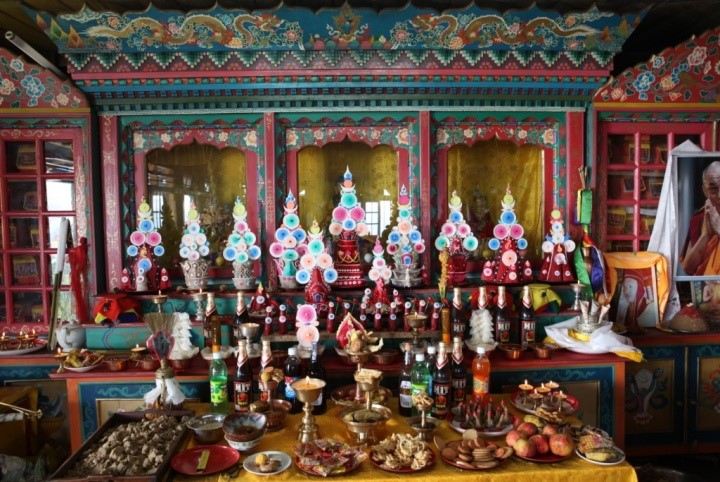
These statues are made of a wide variety of substances including earth, brass, copper, silver and gold and they are filled with sacred mantras (jhung) and blessed. The next important objects are the religious texts (pecha) including the hundreds of volumes of Kangur and the Tengur. Offerings of water, butter lamps and incense are regularly made in front of these holy objects. An important aspect of Sherpa religion is the monastery or gumpa. Many Sherpa villages have their own sect of gumpas. There are some communities of lamas and gyalung (staying unmarried especially for religious purpose) and lead a life in isolation in search of truth and enlightenments. They are also celebrated their religious festivals in the monastery.
3. Food Habits
The Sherpas are usually non-vegetarian. The Sherpa staple food is potato and wheat from which they prepare varieties of items for their consumption. In addition, they use to drink sujya(tea served with salt and butter) at all meals and throughout the day.
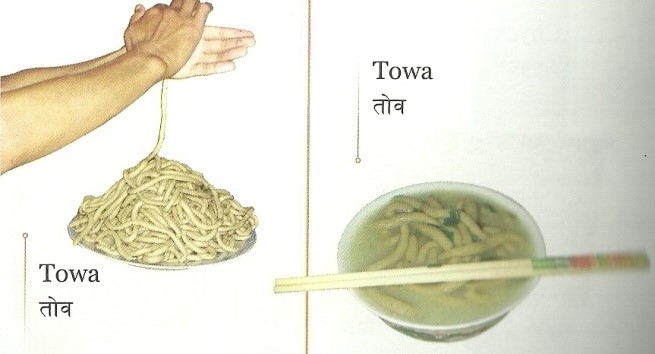
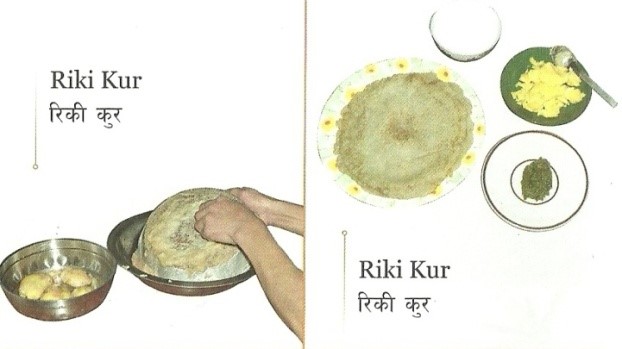
A typical breakfast consists of sujya andchhampha(roasted barley flour) is taken usually. Lunch is eaten in the late morning and may include boiled potatoes which are dipped in ground spices. In the dinner they like to take shen (stiff dough made from flour of grain) with somarshundur (soup of preserved soft cheese) and nurma/durma (mash with potato’s gravy specially served with stiffed dough).
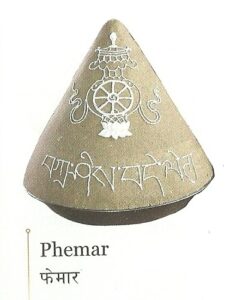
In the Sherpa society their special food is femar (a mixer of roasted corn flour and butter). It is very necessary food in the marriage ceremony. Their some food varieties are; boiled potato with a pickle of aermang (timboor), chhampha (roasted barley flour), rigikur (potato bread), fe-shen (stiff dough made from flour of grain), rildok (mashed potato mixed with wheat flour), pakril (food made from wheat and bread), momo (steam food made from wheat flour with mixing of vegetables & meet), chhen (dried greencorn mixed with meet or vegetable commonly known as phalgi),
shakpa/aeri (a typical strew food consisting of balls of dough & vegetable), nurma/durma (mash with potato’s gravy specially served with stiffed dough), thukpa (noodle made from wheat flour), towa (noodle made from potato), kaksyer (raw corn flex), sharkam (soup of soft fresh cheese) etc are occasionally and seasonally consumed. Dairy products, especially butter and curds, are important in the Sherpa diet. Sherpas eat meat, but as practicing Buddhists they will not kill animals themselves.
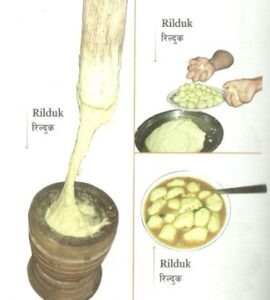
4. Traditional Dresses and Ornaments
Sherpa dresses are similar to that worn by Tibetans. Sherpas live in the high altitude thus it is cold all the year round. For many months the land is snowcovered.The clothing and costumes of the Sherpa people were/are generally made from yak and sheep wool, and colored with natural dye. The wool clothing is very thick to suit the cold environment. Men wear their chhuba to knee length and under it they have a jacket or shirt with a stiff high collar and extremely long sleeves tetung. Women wear a sleeveless chhuba called engi, or a sleeved one called tongok. Over it they wear multicolored striped woolen aprons worn to cover the front and back of the bodies below the waist which is called pangden and gyaptil respectively.
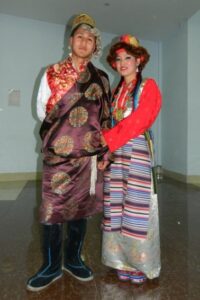
Both sides of pangden have a kingkap (triangle shape stiff) which determines the marital status of the woman.Both males and females wear high, woolen boots with hide soles (docha). The uses of traditional clothing are being confined to a ceremonial occasions. Only Sherpa women, monks and nuns are wearing traditional dresses at all the season. Traditional shyomung (woolen hat) completes the dresses of Sherpa men and women.
Sherpa Ornaments
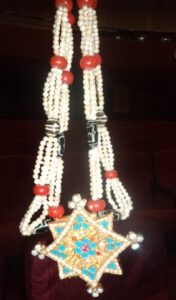
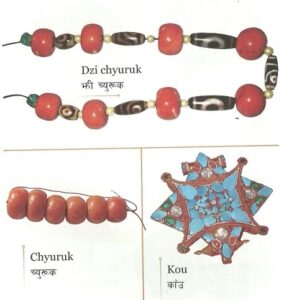
Sherpa Jewelry is very unique and different from the others. There is the apron buckle which is called kyetig. It is a silver buckle that women use to hold the back and the front of their aprons. There are some ornaments which Sherpa women wear in ceremonial occasion and some of them were wear all the time in the villages. They are dzhichhuruk(onyx with coral), mathil (golden bracelet), kaau (golden pendant),inanila (sapphire),dzhi (onyx), pykurkukte (earring), chapchap (silver batch), gyanjyan (golden necklace),dikra (silver and golden chain that is hold in the front waist to the right side shoulder) and tiktik (necklace worn on a special occasion). Lastly, there is an alung. This is a men’s earing. These earrings are made of gold and they have turquoise or coral insets.
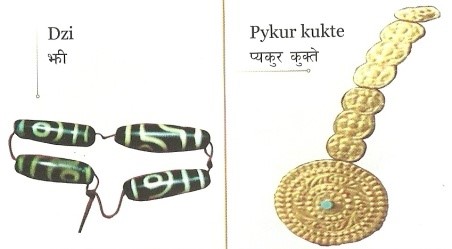
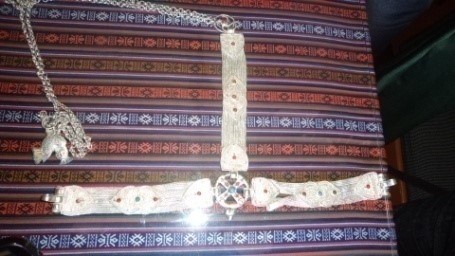

4. Traditional Songs and Dances
Sherpa communities have a rich tradition of folk songs and dances. They sing folks songs to bonds people together, uplifts their spirits and provides recreation and rejuvenation. There is a traditional Sherpa saying –Lu min taam yin – which means songs are not just songs but are a medium of communication. They singselo (Sherpa selo), tashi-sol-che and yangdosiba. Shebdro song is very much popular in the Sherpa community across the world. They perform folk dances such as shebru dance (group dance perform by connecting hands), shyaptuk dance (group dance), nading dance (dance by tapping foot), tashi-sol-che dance (dance performed in marriage ceremony), yangdosiba (ceremonial dance), silluwa dance (the dance performed in marriage ceremony by two dancers with holding sword and yak’s tail), Khayirolyang dance (traditional instrumental dance), dramngyang dance (traditional instrumental dance),chyakikargna dance (traditional instrumental dance), khirkhuley dance (foot stepping dance) and yungmakabu dance (bamboo dance).
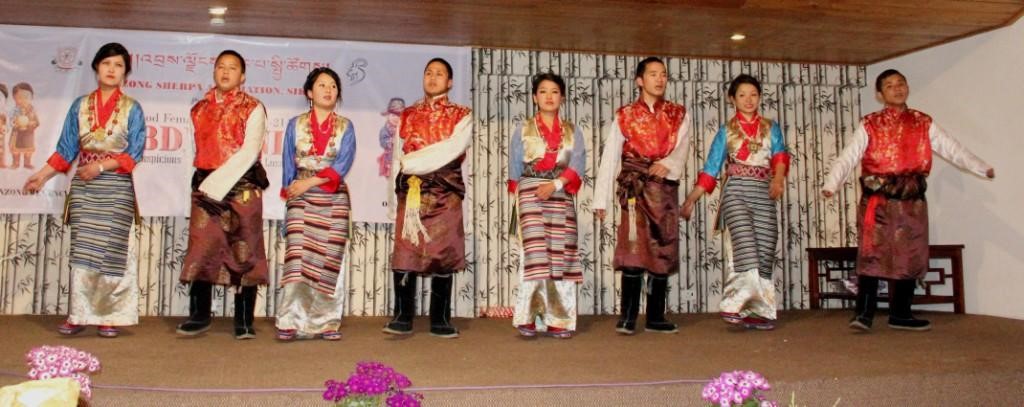
4. Zendi (Marriage)
One of the most important events in Sherpa culture is Tartang/Zendi (Merriage).A marriage is arranged by the mutual consent of the couples’ parents, often respecting the veto of the child. The traditional Sherpa wedding is a lengthy process lasting more than a week. The wedding practices are carried out mainly forpropose of bestowing happiness and prosperity in the couple’s married life.A Sherpa wedding consists of several stages.
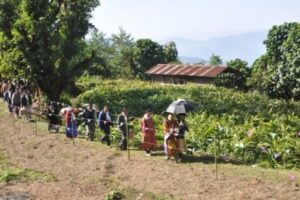
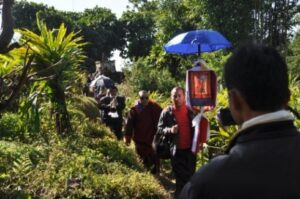

4.1 Longchhag
“Longchhang” is the proposal by the boy’s parents to the girl’s parents asking the hand of the girl in marriage. Before Longchhang, the people from either the boy’s or the girl’s side seek information indirectly regarding the possibility of the marriage. In this step, some members of the boy’s family and relatives (normally two to three in number) visit the girl’s home carrying a “pong” of wine. A pong is a traditional wooden jar used by the Sherpas to keep liquor. They fasten Khatak, a white silk scarf, around the neck of the pong and put some butter on its lid to show their respect to the girl’s parents.An engagement is not approved on the day of the Longchhang by the girl’s parents. The boy’s family returns home and wait for the decision.
4.2 Thichhang
Once the boy and the girl are betrothed, the boy’s and the girl’s parents start preparing for the upcoming marriages processes. “Thichhang” refers to asking the girl’s parents about the necessary things that they need to prepare and bring during the wedding day. This is also known as “Sodene” in Nepali language
4.3 First Pechang
A process called Pechhang, a small meeting between the parents of the girl and the boy’s family, is conducted to make necessary decisions for the wedding. In fact Pechhang is any meeting carried to make certain important decision. For this particular meeting one or two people from the boy’s side go to the girl’s home no matter how far the girl’s home may be.
4.4 Demchhang
A process called Pechhang, a small meeting between the parents of the girl and the boy’s family, is conducted to make necessary decisions for the wedding. In fact Pechhang is any meeting carried to make certain important decision. For this particular meeting one or two people from the boy’s side go to the girl’s home no matter how far the girl’s home may be.
4.5 Chhyawi
In the next step called “Chhyawi”, the boy’s parents provide many bags of millet mixed with maize, approximately thirty “pathi” for wine preparation to the girl’s parents. One “pathi”, is the amount weighing four kilogram. However, in DolakhaKimti, the amount of millet to be provided to the girl’s parents is about sixty pathi and hence the amount varies according to the variation in the place as well. Generally, if the girl’s parents accept the whole thirty pathi then it is the indirect indication to the boys folk that they do not have to bother preparing huge amounts of phemar for the zendi (the weeding day).
4.6 Second Pechang
Two or three weeks prior to the wedding day, the boy’s and the girl’s family members hold a gathering of the villagers to inform them about the marriage. The parents ask for the villagers’ support during the wedding. The members of the bride and the bridegroom ask the villagers and their relatives to estimate how many people will be present during the wedding day. Then the preparation for the wedding day starts. The villagers and their relatives gather, discuss among themselves and choose some relatives representatives to collect money from those who will be present during the wedding day. The money, which they collect, is invested for the various parties during the wedding. The active participation of the Sherpas in the fulfillment of the communal responsibility shows their respect for Buddhist ideologies of compassion.
4.7 Zendi or Chhangdu (the wedding day)
“SippaKhorlo”, a special flag which is representing the wheel of cycle existence.It holds in front of janti(people in the procession). It is believed that the Khorlo protects the “Janti” from all the evils that they may encounter on the way to the girl’s home. It is believed to overpower all the evils that come from any of the direction it faces.
The groom takes Dhattar, PhumbaandDuflong along with him and the main Ngagpa (married priest) carries with him the SippaKhorlo. The dancers carry Sword, Bukchal (cymbals), Gelings (long metallic flutes) and yak’s ngama (yak’s tail). The “janti” also take the requested number of phemar, wine,khatak and chhang. These kinds of cymbals: one small and two large, distinguished with small bosses (Sil-nyen) are held vertically and used in offerings to peaceful deities. Those with large central bosses (Buk-chal) are held horizontally and used in prayers to fierce deities. The small cymbals (Ting-sha) are used in offering rituals. Dhattar represents a stick fastened with five different striped clothes. Dhattar is thought to bring power and prosperity. Phumba is a pot, the shape of which is like a flat shaped jar with a pipe to bring out the water from the pot and which is richly decorated with precious stones and metals. Phumba is normally found placed on altar in the Sherpa homes to keep water perhaps the most important in Buddhist rituals, as an offering to the god. Phumba is thought to increase the life span of the bridegroom.
During the wedding, the use of many instruments comes into play. The sounds of instruments are thought to bring us closer to the Gods by making people happy, one of the many small steps on the path to the enlightenment.
The bride wears five layers of clothes topped up by floor-length-embroidered tunic and two aprons. The bridegroom is dressed in a colorful chuva that is symbolic of a king whereas that of the bride is symbolic of a Queen. He is treated like a king with an umbrella carried by the Kelmi over his head. The Kelmi is the best man usually his cousin or brother who is not yet married.
The bride’s parents introduce themselves to the bridegroom’s party and kindly ask whether their journey was safe and enjoyable. This process is known as NgosiTomsi. The host family hands Siljang, a chhang which is offered to the bridegroom as an indication that he is now free to take his cloak off and to take some rest. When this has been done, the bridegroom’s parents hand over kyakiphemar and khatak to the bride’s parents and relatives. Parents of the bride’s family then greet the guest and inquire whether their journey has been safe and peaceful.
All the guests then have their dinner. Some important members of the groom enter the girl’s home to present Phemars and Khataks. In the mean time, guns are fired in the air outside the home. This process is known as ChhiniGegug. Once again both the party of the bridegroom and the bride perform SyorkiTomsi to each other. The Ngagpa then reads out Mola, a public announcement of the marriage.
The Ngagpa who recites Mola should have a good knowledge of the religion; its history, significance and its association to the wedding. He is given Khatak and Chhang by the members of the bride and the bridegroom, cordially requesting him to read out the Mola on their behalf. Then all the guests rhythmically utter in loud voice “Khu-A, Khu-A” in a wave like fashion to show their acceptance of the marriage. In other words,Khu-A means that we now happily accept the girl then followed by the song sung by the members of the groom.
The marriages are treated as holy union between two souls. It has always been an event of social and customary importance.
4.8 Nor or Chhitong (giving away of dowry)
When the married couple gives birth to a child, the process of giving dowry takes place. While giving the dowry things like the family condition, the behavior of the husband throughout their stay with each other, and other economical problems are taken into account
4.8 Name giving Ceremony
The name-giving ceremony of a Sherpa child is an important event. The local lama (Buddhist spiritual leader) is informed of the birth and the time that it occurred. On the basis of this information, the lama determines the child’s name and when the naming ceremony should take place. Children,their first name is often named after the name of the day of the week on which they were born. Thus a baby born on Friday would be called “Pasang” (the Sherpa word for “Friday”). The lama, relatives, and neighbors are invited to celebrate the name-giving at a feast.
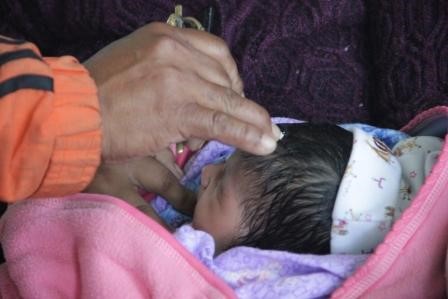
4.8 Death Rituals
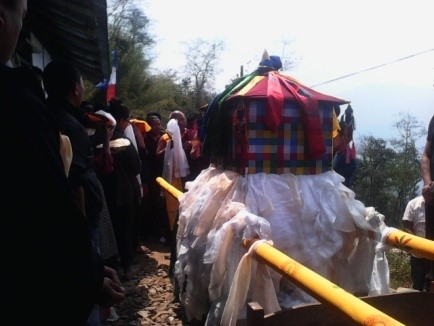
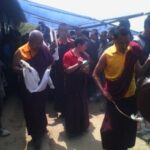
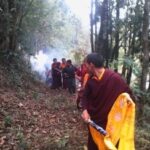
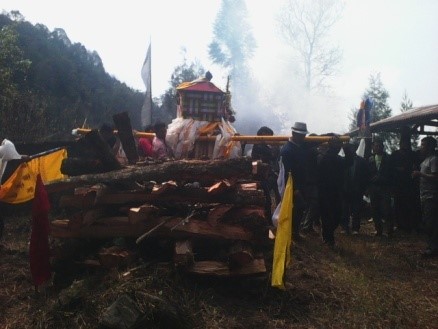
Funerals are the longest and most elaborate life-cycle ceremonies; the body is cremated, and the soul of the deceased is encouraged, through ritual action and instruction, to seek an advantageous rebirth.When a person dies, lamas are called immediately to perform rituals to try to generate good, positive energy for the deceased. There are many different customs, but, usually, the body is kept for three days then cremated. The remnants of the fire mixed with clay and are made into tsatsa that are left in achortenor under a large rock at the end of 49 days.
Every seven days after the death, special prayers (denjen) are offered in the homeof the deceased or in the monastery until 49 days. One head lama is staying at the deceased home and every morning and evening in the same time the head lama offeringsurbi(mixture of nine items made by chhampa, minduk, milk, cord, butter, honey, black suger, sakker) on the fire’s hot coals for the spirit of the deceased until 49 days. The Bardo for 49 days after the death is the time and space between lives, by the end of which the person’s next life is determined and they may be reborn.

